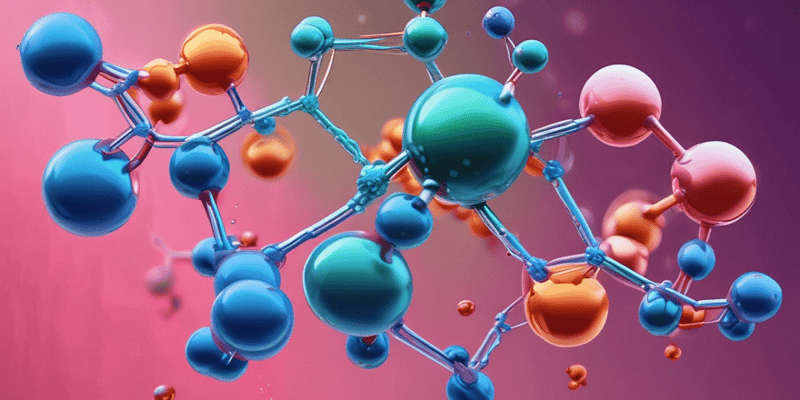Podcast
Questions and Answers
In a d-block atom, d-electrons are bound more weakly than valence s-electrons.
In a d-block atom, d-electrons are bound more weakly than valence s-electrons.
False
When a d-block atom becomes a cation, the d-electrons are lost before the s-electrons.
When a d-block atom becomes a cation, the d-electrons are lost before the s-electrons.
False
All d-block elements are metals.
All d-block elements are metals.
True
Gold (Au) is a poor electrical conductor among d-block elements.
Gold (Au) is a poor electrical conductor among d-block elements.
Signup and view all the answers
Mercury (Hg) is a solid at room temperature.
Mercury (Hg) is a solid at room temperature.
Signup and view all the answers
The element manganese (Mn) can exhibit seven oxidation states.
The element manganese (Mn) can exhibit seven oxidation states.
Signup and view all the answers
The atomic radius generally increases from Sc to Ni in d-block elements.
The atomic radius generally increases from Sc to Ni in d-block elements.
Signup and view all the answers
Copper (Cu) is identified as a yellow metal among the d-block elements.
Copper (Cu) is identified as a yellow metal among the d-block elements.
Signup and view all the answers
Elements at the ends of each row of the d-block tend to have multiple oxidation numbers.
Elements at the ends of each row of the d-block tend to have multiple oxidation numbers.
Signup and view all the answers
The d-orbitals can accommodate a maximum of 10 electrons.
The d-orbitals can accommodate a maximum of 10 electrons.
Signup and view all the answers
Transition metals are typically found in the f-block of the periodic table.
Transition metals are typically found in the f-block of the periodic table.
Signup and view all the answers
Pharmaceuticals commonly involve the use of d-block elements like iron and copper.
Pharmaceuticals commonly involve the use of d-block elements like iron and copper.
Signup and view all the answers
The recommended daily intake of minerals in multi-vitamin preparations is expressed as a percentage of the EU RDA.
The recommended daily intake of minerals in multi-vitamin preparations is expressed as a percentage of the EU RDA.
Signup and view all the answers
All d-block elements can only exhibit oxidation numbers up to +5.
All d-block elements can only exhibit oxidation numbers up to +5.
Signup and view all the answers
Potassium is not considered a d-block element.
Potassium is not considered a d-block element.
Signup and view all the answers
Ferrous fumarate is a compound that contains both iron and d-block elements.
Ferrous fumarate is a compound that contains both iron and d-block elements.
Signup and view all the answers
Silver, gold, and platinum are classified as d-block elements and are known as precious metals.
Silver, gold, and platinum are classified as d-block elements and are known as precious metals.
Signup and view all the answers
Overall, d-block elements are not widely used as catalysts in chemical reactions.
Overall, d-block elements are not widely used as catalysts in chemical reactions.
Signup and view all the answers
The electronic configurations of d-block elements are defined by the occupation of p-orbitals.
The electronic configurations of d-block elements are defined by the occupation of p-orbitals.
Signup and view all the answers
Transition metals include only metals used in construction, such as iron and copper.
Transition metals include only metals used in construction, such as iron and copper.
Signup and view all the answers
The atomic radii of elements in the third row are significantly larger than those in the second row.
The atomic radii of elements in the third row are significantly larger than those in the second row.
Signup and view all the answers
The first ionisation energy of Scandium is 632 kJ.mol–1.
The first ionisation energy of Scandium is 632 kJ.mol–1.
Signup and view all the answers
The atom with the highest density in Period 6 is Iridium at 22.61 g/cm3.
The atom with the highest density in Period 6 is Iridium at 22.61 g/cm3.
Signup and view all the answers
The atomic masses of Period 6 elements are approximately the same as those of Period 5 elements.
The atomic masses of Period 6 elements are approximately the same as those of Period 5 elements.
Signup and view all the answers
There is a trend from left to right across the table where first ionisation energies decrease.
There is a trend from left to right across the table where first ionisation energies decrease.
Signup and view all the answers
The 6th element in Period 6 is Tungsten.
The 6th element in Period 6 is Tungsten.
Signup and view all the answers
Atomic radii in Period 6 are comparable to atomic radii in Period 5.
Atomic radii in Period 6 are comparable to atomic radii in Period 5.
Signup and view all the answers
The conversion of 1 pm (picometer) is equal to 10–9 m.
The conversion of 1 pm (picometer) is equal to 10–9 m.
Signup and view all the answers
The 5th, 6th, and 7th elements in Period 6 are Ta, W, and Re respectively.
The 5th, 6th, and 7th elements in Period 6 are Ta, W, and Re respectively.
Signup and view all the answers
The 2nd and 3rd row elements exhibit different trends in atomic radii and ionisation energies.
The 2nd and 3rd row elements exhibit different trends in atomic radii and ionisation energies.
Signup and view all the answers
Study Notes
d-Block Elements
- The d-block elements are known as transition metals.
- They are commonly used in various applications, including construction, technology, pharmaceuticals, and precious metals.
- d-block elements have electron configurations with occupied d-orbitals.
- When d-block atoms become cations, they lose valence s-electrons first, followed by a variable number of d-electrons.
- Each row of the d-block contains 10 elements.
- All d-block elements are metals and generally exhibit malleability, ductility, luster, silver-white color, and high melting and boiling points.
- Exceptions include mercury (Hg) as a liquid at room temperature, copper (Cu) as red-brown, and gold (Au) as yellow.
- d-block elements play a crucial role in multi-vitamin preparations and infant formula.
Oxidation Numbers of d-Block Elements
- Most d-block elements exhibit a range of oxidation numbers, except for mercury (Hg), zinc (Zn), and cadmium (Cd), which have only one oxidation number besides 0.
- Scandium (Sc) has only +3 oxidation state, while zinc (Zn) has only +2 oxidation state.
- Elements near the center of each d-block row display the widest range of oxidation states.
- Elements on the left and in the second and third rows tend to form compounds with higher oxidation states.
Atomic Radii of d-Block Elements
- Atomic radii decrease from scandium (Sc) to nickel (Ni) due to increasing nuclear charge and poor shielding of the d-electrons.
- The atomic radius of a 3d64s2 iron (Fe) atom is smaller than a 3d14s2 scandium (Sc) atom despite Fe having more d-electrons.
- The atomic radii of elements in the third row are comparable to those in the second row, displaying a phenomenon called lanthanide contraction.
Densities of d-Block Elements
- Elements in the sixth row have relatively high densities, particularly osmium (Os) and iridium (Ir).
- The high densities of sixth-row elements are due to their atomic masses being roughly twice as large as those in the fifth row, while having similar atomic radii.
First Ionization Energies of d-Block Elements
- The first ionization energy represents the minimum energy required to remove the most loosely bound electron from an atom.
- First ionization energies generally increase from left to right across the d-block due to increasing nuclear charge.
- Second and third-row elements exhibit a similar general trend in atomic radii and ionization energies.
Studying That Suits You
Use AI to generate personalized quizzes and flashcards to suit your learning preferences.
Related Documents
Description
Test your knowledge on d-block elements and their properties in this insightful quiz. Explore topics such as electron configurations, oxidation numbers, and applications of transition metals. Perfect for chemistry students looking to deepen their understanding of this fascinating section of the periodic table.




